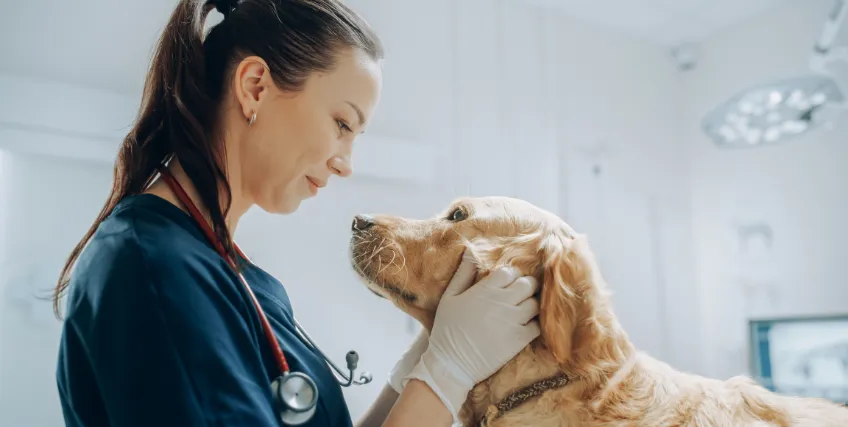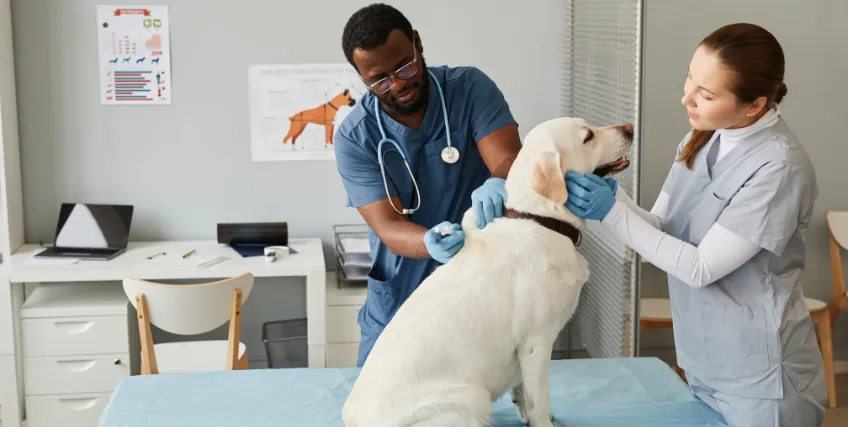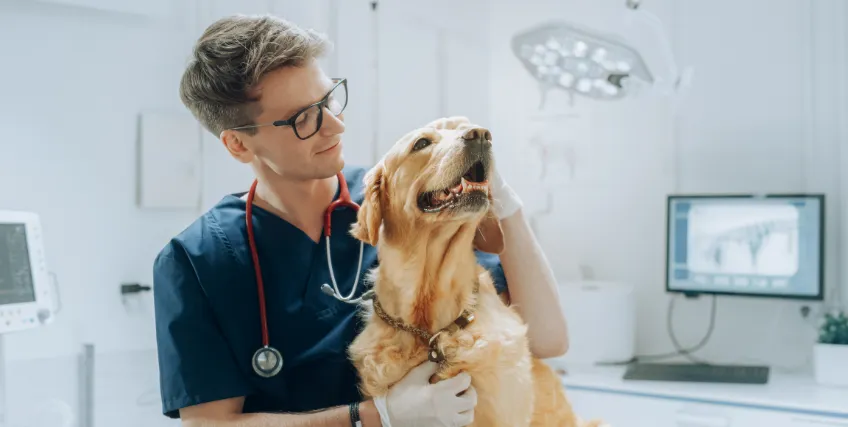Financing for Veterinary Care: Loan Options to Grow Your Clinic
October 27, 2025 | Last Updated on: October 27, 2025

Key Takeaways:
- How financing for veterinary care supports growth, cash flow, and client experience in today's competitive environment.
- A breakdown of veterinary financing options, including SBA 7(a), SBA 504, equipment loans, term loans, and lines of credit.
- What lenders look for during the veterinary loan application process, and how to improve your chances of approval.
- Practical tips on client payment options, compliance, and common financial planning pitfalls to avoid.
Demand for high-quality veterinary care has been on the rise, but margins at many veterinary clinics are still tight. While new imaging, lab, and surgical technology improves outcomes, it also raises capital needs. Staffing is harder and more expensive as well.
That's where financing for veterinary care becomes a great helping hand. With the right financing options, vet clinics can buy necessary equipment, open a second vet clinic, add mobile or urgent-care capacity, modernize digital front doors, smooth cash flow, and invest in preventive pet care programs that keep patients loyal.
In this article, discover how veterinary practice financing works, compare veterinary practice loans and medical practice loans, and see where government-backed programs like SBA 7(a) and 504 fit into the growth plan, along with the tax angles that help lower after-tax cost of capital.
Why get Financing for Veterinary Care?
Running a veterinary clinic is not an easy quest. It needs a good balance of compassion, patience, and financial stability. This is because the cost of delivering quality pet care continues to climb as modern diagnostics, specialized treatments, and staff development demand significant investment.
Access to financing for veterinary care helps clinics upgrade their infrastructure and equipment. This helps them meet customer expectations by fulfilling their demands. A loan for a veterinary practice can help a clinic pursue its long-term growth without affecting the day-to-day cash flow.
The right funding allows veterinary practices to modernize facilities with digital radiography, ultrasound, dental X-ray, and point-of-care analyzers. With these funds, vets can introduce new revenue lines such as rehabilitation, oncology, or urgent-care services and enhance their clinic's infrastructure.
During cycles of wellness check-ups, vaccinations, and surgeries, it is convenient to manage seasonal cash flow. Financing for veterinary care also enables clinics to recruit and retain skilled providers by freeing up funds for competitive compensation. You can use these funds to enhance the client experience through teletriage, contactless payment options, and financing tools for pet owners.
Loan options for veterinary practices
1) SBA 7(a)
Use SBA 7(a) loans for acquisitions, buildouts, equipment, working capital, or refinancing eligible debt. The interest rates are negotiated with lenders.
When 7(a) is a good option for financing for veterinary care
- Acquisitions / partner buy-ins
- Leasehold improvements / buildouts
- Working capital for hiring, inventory, and outreach
- Refinancing expensive short-term debt into longer terms
Tips: Lenders will underwrite cash flow, credit history, eligibility, and management experience. Strong history, clean credit check, and a clear plan for repayment help you secure credit approval and better interest rates. Many lenders allow you to prequalify quickly, so ask about SBA packaging to streamline how it works end-to-end.
2) SBA 504
If your plan includes buying a building, constructing a hospital, or purchasing big equipment (MRI/CT, surgical robotics, oxygen systems), the SBA 504 program provides long-term, fixed-rate capital via a Certified Development Company (CDC). 504's fixed debenture is attractive when you want certainty in monthly payments.
When 504 is a good option for financing for veterinary care
- Owner-occupied real estate (purchase, build, expand)
- Large equipment with a long useful life
- Lower down payment compared with many conventional loans
3) Equipment financing
For mid-ticket purchases like digital dental X-ray, ultrasound, in-house analyzers, the equipment loans and leases help you preserve cash. The tax code strengthens financing for veterinary care by enabling accelerated cost recovery, that can materially reduce your after-tax cost.
4) Term loans
A term loan complements financing for veterinary care when you want predictable amortization for renovation, marketing, or adding a second vet clinic.
What lenders look for:
- 3 years of financials (P&L, balance sheet), YTD results, projections
- A/R aging quality and payer mix
- Debt service coverage and loan amounts requested
- Owner resume and credit history
5) Medical practice loans vs. veterinary practice loans
Many banks market medical practice loans to physicians, dentists, and veterinarians together. Veterinary practice loans often mirror those structures but may flex underwriting to animal-health revenue cycles (e.g., wellness plans, dental, surgery, urgent care). In either case, financing for veterinary care benefits from lenders who understand seasonal patterns (flea/tick peaks, heartworm testing cycles) and how payment options for clients affect A/R.
Ask lenders if they:
- Finance start-ups (or require existing cash flow)
- Offer acquisition multiples based on EBITDA
- Allow interest-only during build-out
- Permit early payoff with no prepayment penalties
Application process: Financing for Veterinary Care
1) Prepare the package
- 3 years business tax returns + YTD financials
- Personal tax returns (for guarantors)
- Debt schedule and equipment quotes
- Business plan or project memo with ROI and timeline
- Personal financial statement and credit check authorization
2) Underwriting focus
- Cash flow and debt service coverage
- Eligibility for SBA programs and use of proceeds
- Collateral where relevant (for 7(a), lenders follow SBA rules)
- Management depth and provider retention plan
3) Tips to improve approval odds with financing for veterinary care
- Demonstrate recurring revenue via wellness plans, membership payment plans, and strong reimbursement capture
- Show a clear payer-mix strategy and pricing model that supports monthly payments stability
- Tighten A/R policies and client payment options to reduce veterinary bills aging
- Document compliance and healthcare quality initiatives (patient safety, controlled-substance logs)
4) Timeline and closing
- 7(a) and 504 timelines vary by lender/CDC so ask for a realistic schedule and checklist up front from your partner. SBA confirms that 7(a) rates are negotiated within SBA maximums pegged to prime/optional peg, which your lender will disclose in the term sheet.
Client-friendly Payment Options
Following are some of the client-friendly payment options that do not hurt the cash flow of the clinic, and hence, helps build a loyal customer base:
- Healthcare credit card options like CareCredit can reduce bad debt and fund large vet bills at point of sale. The “no interest if paid in full” promos are typically deferred interest which means if clients miss the promo payoff, interest charges at high APRs can accrue retroactively. You must train staff to disclose this clearly as it is customer's risk, not the clinic's.
- Installment providers (e.g., Scratchpay) let clients split costs without the clinic carrying receivables.
- Keep annual fees out of membership plans by pricing simply and focusing on wellness value for pet parents.
- Share a clear financial assistance policy and nonprofit resources to support clients in need.
- Offer payment plans, credit card, ACH, and other payment options upfront to help avoid sticker shock during estimates.
Compliance, Risk, and Practical guardrails with Financing for Veterinary Care
When structuring financing for veterinary care, it's helpful to align loan terms with your clinic's operational timelines. Fixed-rate or long-amortizing loans can reduce surprises, while variable-rate options should be stress-tested for potential increases.
Review loan covenants for seasonal flexibility, and if using client financing tools, ensure your staff understands how it works and communicates clearly, especially regarding fees or prepayment penalties. Linking each investment to measurable outcomes, such as faster dental turnaround or more spay/neutering capacity, can support better financial planning.
Common Mistakes to Avoid with Financing for Veterinary Care
When planning financing for veterinary care, it can be helpful to keep a few common considerations in mind:
- Scope all related costs. Project budgets often extend beyond construction or equipment. Including elements like IT infrastructure, signage, permitting, marketing, and ramp-up working capital provides a more complete financial picture.
- Match loan structure with asset life. Using short-term financing for long-lived equipment or improvements can create repayment pressure. Aligning term lengths with asset use may offer better stability.
- Coordinate with tax timing. Larger purchases may be eligible for Section 179 or bonus depreciation, so planning purchase dates with your tax advisor can be beneficial.
- Monitor accounts receivable closely. Offering client-friendly payment plans or third-party financing tools can help maintain predictable cash flow while supporting pet owner access to care.
- Use credit cards carefully. While useful for day-to-day or travel expenses, credit cards typically carry higher interest rates and may not be the most efficient way to finance larger projects.
- Explore multiple lenders. Terms and eligibility for veterinary and medical practice loans can vary between lenders, so comparing options may help you find a better fit.
- Plan for contingencies. Many clinics find it useful to include a buffer to cover potential cost overruns, especially with construction or technology investments.
Final Thoughts
Financing for veterinary care plays a valuable role in supporting both day-to-day operations and long-term growth. Rather than being solely about access to credit, it's about building a thoughtful capital strategy that supports efficiency, staff continuity, and financial flexibility.
By combining tools such as veterinary practice loans, tax-aligned planning, and client-friendly pet financing options, clinics can explore growth opportunities without placing unnecessary strain on working capital. Whether the goal is to expand service offerings, adjust clinic hours, or invest in a new location, aligning financing with the clinic's broader financial goals and operating margins can help support sustainable progress.
FAQs About Financing for Veterinary Care
1. What are some common ways to finance a new veterinary location?
An SBA 504 loan may be used for real estate and large fixed assets, while an SBA 7(a) loan or a business line of credit can support working capital and equipment purchases. Exploring different structures with your lender can help balance interest rates, down payment requirements, and monthly payments.
2. Which loan type works best for new equipment purchases in financing for veterinary care?
For long-term equipment installed in your facility, an SBA 504 loan can be an efficient option. For smaller or mid-range purchases, an SBA 7(a) or dedicated equipment loan may work well. Clinics can also explore Section 179 deductions and bonus depreciation to improve after-tax savings.
3. What are the typical interest rate limits for SBA 7(a) loans?
SBA 7(a) loan rates are generally negotiated between the borrower and lender but must stay within SBA's published maximums. These caps are based on the prime rate plus an allowable spread, which varies by loan size and term. Understanding these limits can help clinics compare offers more effectively.
4. Can clinics deduct or expense new veterinary equipment in the same year?
Many clinics can use Section 179 expensing to deduct qualifying equipment purchases in the same tax year, within IRS limits. Always confirm eligibility with your CPA before making major investments.
5. How can veterinary clinics support pet owners with limited financial means while maintaining cash flow?
Clinics can offer flexible payment options such as third-party financing through platforms like CareCredit or Scratchpay, or structured payment plans for recurring services. Transparent communication about deferred interest and clear billing policies helps avoid misunderstandings. Some practices also collaborate with nonprofits or local pet-welfare groups to provide limited financial assistance in hardship cases.
6. How are changes in veterinary service costs affecting financing needs?
According to the Bureau of Labor Statistics, veterinary service prices increased steadily as of August 2025. This rise highlights the importance of regularly reviewing your clinic's pricing models and aligning repayment schedules with projected revenue.
Frequent searches leading to this page
Related Articles
Term Loans are made by Itria Ventures LLC or Cross River Bank, Member FDIC. This is not a deposit product. California residents: Itria Ventures LLC is licensed by the Department of Financial Protection and Innovation. Loans are made or arranged pursuant to California Financing Law License # 60DBO-35839




